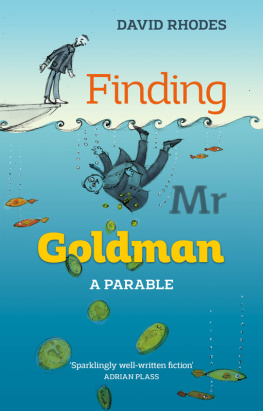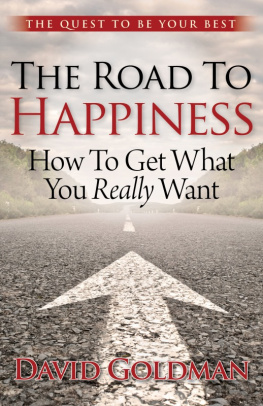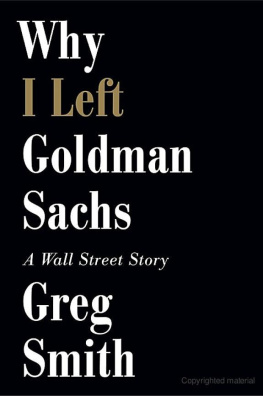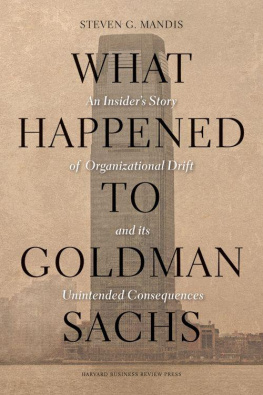STEVEN G. MANDIS
WHAT
An Insiders Story
HAPPENED
of Organizational Drift
TO
and its
GOLDMAN
Unintended Consequences
SACHS?
Harvard Business Review Press
Boston, Massachusetts
Copyright 2013 Harvard Business School Publishing
All rights reserved
The views and opinions expressed in this book are strictly those of the author and do not necessarily reflect those of any organization with which the author has been or is affiliated. The contents of this book have not been approved by any organization with which the author has been or is affiliated. Analyses performed within this book are based on theories, are only examples, and reply upon very limited and dated information and require various and subjective assumptions, interpretations, and judgments. The authors opinions are based upon information he considers reliable; however, it may be inaccurate or may have been misinterpreted. The reader should not treat any opinion expressed in this book as a specific inducement to make a particular investment or follow a particular strategy, but only as an expression of the authors opinion.
No part of this publication may be reproduced, stored in or introduced into a retrieval system, or transmitted, in any form, or by any means (electronic, mechanical, photocopying, recording, or otherwise), without the prior permission of the publisher. Requests for permission should be directed to , or mailed to Permissions, Harvard Business School Publishing, 60 Harvard Way, Boston, Massachusetts 02163.
Library of Congress Cataloging-in-Publication Data
Mandis, Steven G.
What happened to Goldman Sachs: an insiders story of organizational drift and its unintended consequences/Steven G. Mandis.
pages. cm
ISBN 978-1-4221-9419-5 (hardback)
1. Goldman, Sachs & Co. 2. Investment bankingUnited StatesManagement.
3. Corporate governanceUnited States. 4. Global Financial Crisis, 20082009. I. Title.
HG4930.5.M36 2013
332.660973dc23
201301870
The web addresses referenced in this book were live and correct at the time of the books publication but may be subject to change.
ISBN: 9781422194195
eISBN: 9781422194201
This book is dedicated to my devoted wife, Alexandra, and my two loving
daughters, Tatiana and Isabella. They were my cheerleaders through many
long days and nights of working, studying, and writing.
I would also like to thank my parents, George and Theoni, who immigrated
to America from Greece with very little money and no knowledge of English.
They quietly sacrificed so that my brother Dean, my sister Vivian, and I
could have a better life. They taught us the meaning of values and hard work
as well as the power of the combination of these two qualities. They asked
for only one thing in returnfor us to strive to give our children more opportunities
than they had been able to give us.
Contents
Prologue
A Funeral
O N SEPTEMBER 25, 2006, I FILED INTO THE MEMORIAL service for John L. Weinberg, senior partner of Goldman Sachs from 1976 to 1990. More than a thousand people filled Gotham Hall in New York to pay their respects. John L. (as he was often referred to within Goldman, to distinguish him from other Johns at the firm) was the product of Princeton and Harvard Business School and the son of one of the most powerful Wall Street bankers, Sidney Weinberg, who had literally worked his way up from janitor to senior partner of Goldman and who had served as a confidant to presidents.
The program listed a Goldman honor roll of those who would speak, including Lloyd Blankfein, the firms current chairman and CEO; John Whitehead, who had run the firm with John L.the two of them were known as the Johnsand who had left Goldman in 1985 to serve as deputy secretary of state; Robert Rubin, who had gone from co-senior partner in the early 1990s to secretary of the Treasury; Hank Paulson, who had run Goldman when it went public on the New York Stock Exchange (NYSE) in 1999 and had just become secretary of the Treasury; John S. Weinberg, John L.s son and current vice chairman of Goldman; and Jack Welch, former chairman and CEO of General Electric and a long-standing client of John L.s.
Welchs eulogy stood out. His voice cracking, holding back tears, he said, I love you, John. Thanks for being my friend. Imagine a CEO today saying that about his investment banker and almost breaking down at the bankers memorial service.
John S. tried to lighten the mood with a funny line: My fathers favorite thing in life was talking to his dogs, because they didnt talk back. But he caught the essence of John L. when he said, He saw right and wrong clearly, with no shades of gray. John L. was a veteran, having served in the US Marine Corps in both World War II and Korea, and the recessional was the Marine Hymn. The lyrics keep our honor clean and proud to serve seemed to provide a perfect end to the service.
From 1976, when the two Johns became cochairmen, until John L.s death in 2006, Goldman grew from a modest, privately owned investment banking firm focused on the United Stateswith fewer than a thousand employees, and less than $100 million in pretax profitsto the most prestigious publicly traded investment bank in the world. The firm boasted offices all over the globe, more than twenty-five thousand employees, almost $10 billion in pretax profits, a stock price of almost $200 per share, and an equity market valuation of close to $100 billion.
I had left Goldman in 2004 after a twelve-year career, a few months after my Goldman IPO stock grant had passed the five-year required vesting period. I had moved on to become a trading and investment banking client of Goldmans. I went to John L.s memorial service out of respect for a man I had known and admireda Wall Street legend, although one would never have guessed that from his demeanor. I also wanted to support John S., whom I considered (and still consider) a mentor and a friend. (See for an annotated list of key Goldman partners over the years.)
I first met John L. in 1992, when I was a Goldman financial analyst six months out of college. The legend of Sidney and John L. Weinberg was one of the things that had attracted me to Goldman, and I was excited at the prospect of meeting him. I identified with John L. because we were both sons of parents who came from humble beginnings. I figured if John L.s father could start by emptying spittoons and end up running Goldman, then anything was possible for me, the son of Greek immigrants. My father had started as a busboy at the Drake Hotel in Chicago, and my mother worked at a Zenith TV assembly factory.
I met John L. early in my time at Goldman, as a financial analyst in the M&A department, when I interviewed him as part of a work assignment. I was asked to make a video on the history of the M&A department to be shown at an off-site department outing. Goldman was enthusiastic about documenting and respecting its history and holding off-site outings to promote bonding among the employees. In the interview John L. could not have been more jovial and humble. At the time, Goldman had less than $1.5 billion in pretax profits, and fewer than three thousand employees. Steve Friedman and Bob Rubin, co-senior partners, had embarked on an aggressive growth plangrowing proprietary trading and principal investing, expanding internationally, and spreading into new businesses.
John L. told me that his father had once fired him in the 1950s for what seemed a minor offensewithout the proper approvals, he had committed a small amount of the firms capital to help get a deal done for a clientand how, lesson learned, he had groveled to get his job back. He told me about sharing a squash court as an office with John Whiteheadthe second of the two Johnsbecause there was no other space for them. He talked about integrity and business principles and explained how his military experiences had helped him at Goldman and in life. He told me how proud he was of his family, including his young grandchildren. He took a strong interest in my own family, and I was struck by his asking me to share my fathers stories about his Greek military experiences. John L. asked why I volunteered for Guardian Angels safety patrols and also wanted to know how I had managed to play two varsity sports at the University of Chicago while simultaneously performing community service. He revealed that his two children also played college tennis. Sharing that he liked Chicago, where I was born, he advised me to work with the head of the Chicago office, Hank Paulson, because I would learn a lot from him and it would allow me to fly from New York to see more of my family, something he emphasized was important.







